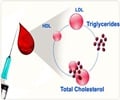- ATP III Guidelines At-A-Glance Quick Desk Reference - (https://www.nhlbi.nih.gov/files/docs/guidelines/atglance.pdf)
- Lipoprotein (a) - (https://labtestsonline.org/tests/lipoprotein-a)
What Do We Measure in a Lipid Profile?
- Total cholesterol- this includes both LDL and HDL levels
- LDL/LDL-C- Low-Density Lipoprotein also called LDL cholesterol
- HDL- High-Density Lipoprotein
- Triglycerides- it causes increased risk of cardiovascular disease, especially in women.
- Lipoprotein a/ Lp (a)- not routinely tested. It tested in people who have an increased risk of early heart disease, a strong family history of heart disease, existing heart disease but with normal LDL or only mildly elevated LDL, familial hypercholesterolemia. Rarely measured in Postmenopausal women due to reduced estrogen levels (5Lipoprotein (a)
Go to source).
Know the Normal Values of Lipid profile-
1. Total cholesterol-
- Less than 200mg/dl is considered normal
- 200-239mg/dl is considered moderately high
- 240mg/dl and above is considered high
2. LDL- Higher the level more the risk
- Less than 100 mg/dl is considered to be optimal
- 100-129mg/dl is considered above optimal
- 130- 159mg/dl is considered borderline high
- 160-189mg/dl is considered high
- 190mg/dl and more is considered very high
3. HDL- Higher level lessens the risk
- Less than 40mg/dl is low
- More than or equal to 60mg/dl is high and lowers the risk
4. Triglycerides- 10-150 mg/dl is normal, >150mg/dl is high and increases the risk
5. Lp (a)- normal is less than 30mg/dl anything above 30mg/dl increases the risk for ASCVD
Special requirements for testing lipids - a blood sample should be taken after a 12 hour fast- that is no food or drink except water (3ATP III Guidelines At-A-Glance Quick Desk Reference
Go to source) (5Lipoprotein (a)
Go to source).

What do the Results Indicate?
High levels of LDL and triglycerides increase the risk for heart disease. Where as a higher level of HDL is desired, to protect against heart disease.
A high level of triglyceride, LDL and other types of lipoproteins are also indicative of genetic causes of increased cholesterol like- Familial hypercholesterolemia or Abetalipoproteinemia. This population are prone to early heart disease.
A very high triglyceride level can also be seen in some cases of pancreatitis.
High levels of Lp(a) are associated with increased risk of heart disease, independent of other lipid levels i.e. even in scenarios of normal lipid panel (5Lipoprotein (a)
Go to source).








